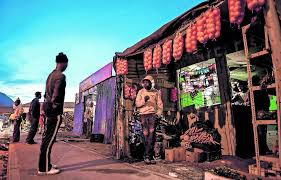
THE fact that food should not be in the hands of corporates is no longer questionable. This is confirmed by the rise in local initiatives like community seed banks and various efforts to raise the profile of grassroots efforts and home-grown solutions. In addition to pushing back against corporates determined to capture African food systems, community seed banks demonstrate the extent to which communities and farmers have a key role in building diversity for the whole world.
Why community seed banks?
While African governments may have been captured by private seed companies, development agencies have played a positive role in supporting the establishment of community seed banks in many African countries. What gives the community seed bank concept more power and relevance is that it adopts traditional and cultural practices that recognise soil and seed as the main foundations for food sovereignty.
However, the biggest threat to community seed banks is the prevalence of a competitive landscape where community seed banks are competing with industrial seed systems which do not start as seed and end there but seed is part of a wide range of commercial products.
With tacit approval from policy-makers and government research institutions, proponents of industrial seed continue to promote the advantages of industrial seed systems against indigenous seed systems.
Starting at production level, these proponents of industrial seed talk about productivity, early maturity and drought tolerance as some of the advantages associated with industrial hybrids. This message is designed to portray industrial hybrids as having more comparative advantages against natural indigenous seeds.
For instance, some agronomists say hybrid maize can yield 10 tonnes per hectare while finger millet can yield three tonnes per hectare. Such a message is deliberately tailored to undermine small grains to the advantage of hybrids. As if that is not enough, there has been huge investments in appropriate technologies for hybrids compared to appropriate technologies for indigenous seeds like small grains and tubers.
Along formal supply chains, various products are produced from industrial seed through mechanised value addition processes to ensure the final product has more comparative advantages over indigenous food systems, for instance in the form of low prices.
- Embracing green buildings to save energy
- Time, gentlemen, please
- Brand partnerships
- Business opinion: Brand storytelling
Keep Reading
Food products from industrial seeds are associated with less cooking time and the fact that more is produced per area through industrial processes ensures the final products lend on the market cheaply than indigenous food. There has also been a tendency, through persuasive advertisements, to attach nutrition to industrial products as part of the value proposition yet nutrition can be more associated with indigenous food.
Hidden costs of industrial seed systems
The whole industrial food production process emphasises advantages of industrial systems while ignoring the hidden costs of industrial processes and food systems. For example, starting from production, what is the environmental cost of using industrial methods in terms of soil, water and biodiversity? Along values chains, what is the impact of industrial processes on culture and tradition?
What are the long-term effects of using chemicals and preservatives in food to human health? With no one conducting analyses to answer such questions, African countries continue to grapple with unexplained diseases which could be linked to industrial food systems.
Positioning community seed banks
It is against the above background that community seed banks are expected to make a difference in a competitive environment where industrial seed systems are well-supported with resources and enjoy recognition as well as protection from national policies.
For instance, industrial seed systems and related practices are heavily promoted in national programmes while indigenous food systems are mentioned in passing. Farmers and communities who should be championing the transition back to indigenous food systems are often powerless to openly contradict national policies that are pushing industrial seed and related food systems.
Thankfully, some development agencies are vigorously supporting, reviving and protecting indigenous food systems through community seed banks, food festivals and other approaches. However, the main challenge is that due to limited resources and preferences of some funders, these initiatives are done as projects with selected beneficiaries as opposed to working with entire communities.
Unless a whole community approach is embraced, efforts to set up community seed banks based on projects with few beneficiaries will not stand a chance in a competitive environment that has strong national institutions such as the Grain Marketing Board being used to push industrial seed and related inputs to farming communities who are too poor to resist hand-outs.
Benefits of taking a whole community approach
The main question is how can community seed banks and indigenous food systems be promoted to become viable community enterprises, sources of employment and income? This requires developing and supporting the whole community supply chain systems, beyond a few project beneficiaries.
Whole community approaches led by local leaders should be used starting from production. With enough awareness and empowerment, local leadership should be able to direct the utilisation of all community natural resources like land, water, forests, rivers and others towards food sovereignty.
Advocacy efforts should focus on ensuring land is set aside for indigenous food and upgrading community seed banks to increase food production as part of boosting the economies of scale for indigenous food.
Currently, due to competition for land and other resources between industrial food systems and indigenous food systems, farmers are producing small quantities of small grains and other indigenous foods, making it difficult to achieve economies of scale.
As more land, water and other resources are allocated to indigenous food, industrial food will be replaced by indigenous food systems including natural food such as wild fruits, vegetables and herbs. Traditional leaders should be empowered to declare that each farmer has to dedicate at least three-quarters of his/her land to indigenous food.
Boosting production will invite investors in appropriate technology which is necessary to support indigenous food.
Currently, an entrepreneur who spends US$100 000 to acquire appropriate food processing technology may not find enough quantities of small grains to fully utilise the technology.
Ideally, indigenous food should trigger the development of appropriate technologies, the way peanut butter processing has evolved from pestle and mortar to hand-driven technologies and now to motorised or solar technology.
Seed does not exist in isolation
The fact that seed cannot be treated in isolation calls for the need to focus on entire knowledge systems about the community. That way, a whole community approach will nudge communities to answer questions like how do we preserve seed in natural ecosystems like hills, mountain ranges, riverbanks and micro ecosystems that are part of human food production?
How do we connect the natural and human production systems? Many rural communities are now characterised by conflict between natural and human production system? In some cases, shortage of land is causing people to encroach into the natural food system at the expense of wild animals like baboons, birds and bees that end up without food.
When there is no investment in community planning, communities fail to see a holistic picture in terms of the kind of damage that is happening to their environment.
A winning approach should evolve from focusing on community seed banks to protecting the whole ecosystem including micro-climates.
As communities protect their ecosystems, they become more resilient and enjoy the long-term benefits in a changing climate. Protecting ecosystems is also protecting the whole food system including wildlife. That can only be done through building community dialogues on preserving ecosystems and food systems.
Social investors can be persuaded to re-focus their investment as directed by communities and traditional leaders to say, “Any investment coming into the local community should promote indigenous food systems.
For instance, investment in water reservoirs, nutrition gardens or solar technology should have a bigger component supporting indigenous food systems.”
Bringing communities together so that they realise the value of preserving their ecosystems and food systems will anchor the development of commercial pathways around indigenous food so that farmers and communities earn income and create employment.
Community approaches to providing education and awareness should recognise existing knowledge and resources. That is how communities can be organised to be able to convert their resources into reliable economic drivers.
What is attracting farmers to industrial food at the cost of their environment is the need for money, income and survival. Communities and farmers value their natural resources but without means of survival, the motivation to preserve natural resources is compromised and weakened.
At the moment, most African community seed banks lack commercial and sustainability models because they have been set up in communities where demand is low as everyone has the seed.
Community dialogues and food festivals can be powerful advocacy pathways for protecting and recognising indigenous seed, the environment, food systems and ecosystems.
Such conversations are critical in correcting the wrong assumption that indigenous food systems and practices cannot feed Africa. What alternative food systems were considered in arriving at such conclusions?
Charles Dhewa is a proactive knowledge broker and management specialist











